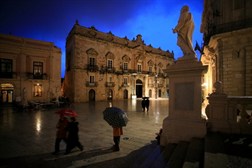1693, a disastrous earthquake
From 9 to 11 January 1693, south-eastern Sicily was hit by a series of devastating earthquakes that forever changed the face of this part of the island. According to the historical reconstructions of seismographs, it was the most violent earthquake ever to hit the Italian territory, with peaks in excess of 7.4 degrees on the Richter scale. About 60,000 people died in those days, and nearly 50 villages were completely destroyed. In particular, the city of Catania was severely affected, since the more powerful earthquake which was registered around 13.30 on 11 January had its epicenter in the stretch of sea off the port of Catania and caused a destructive tsunami that beat down on the coasts of Sicily and Calabria. Catania lost 16,000 of its 20,000 inhabitants in total, but several people were killed in other towns such as Syracuse, Ragusa, AcirealeAcireale is a city in the province of Catania. Like other Sicilian towns that have the prefix Aci (such as Aci Catena, Aci Castello), Acireale also derives from the legendary Xiphonia, the foundation of which is intertwined with the myth of the love affair between the nymph Galatea and the shepherd Acis. The reconstruction after the earthquake of 1693 has made it one of the jewels of Italian Baroque., CaltagironeCaltagirone is a town in the province of Catania, best known for the production of ceramics. Its historic center is a UNESCO World Heritage Site together with the entire Val di Noto. and Palazzolo Acreide.
 Two months later, in March 1693, Giuseppe Lanza, the Duke of CamastraPalermo-born Giuseppe Lanza, the Duke of Camastra (1630-1708) was a magistrate and very close to the Spanish power. The viceroy, the Duke of Uceda himself asked him to organize and lead the reconstruction phase of Catania and the whole of south-eastern Sicily after the devastating earthquake of 1693., was appointed general commissioner for reconstruction by the Duke of UcedaJuan Francisco Pacheco, Duke of Uceda, was Viceroy of Sicily 1687-1696., the Spanish viceroy of Sicily. Camastra enlisted the expertise and experience of a military engineer from the Netherlands, Charles Grunembergh, already known on the island for the fortification work conducted in other cities such as Augusta, Messina and Trapani. Almost all the cities affected by the earthquake were rebuilt on their ruins, while small towns like Ferla, Ispica, Sortino and Buscemi were remade from scratch on new land. Particularly interesting and futuristic at the time were the reconstruction processes put into practice in Noto, Ragusa, Avola and Occhiolà (current day Grammichele), while Catania was equipped with a completely new layout of streets. Along with urban reconstruction, south-eastern Sicily was further enriched by masterpieces of the Baroque, on which some of the greatest Italian interpreters of this unique artistic style worked. In this itinerary will show you some of the most famous buildings, civil and religious, which were erected in various cities in Sicily after the 1693 earthquake (in the photo: piazza Duomo in Syracuse).
Two months later, in March 1693, Giuseppe Lanza, the Duke of CamastraPalermo-born Giuseppe Lanza, the Duke of Camastra (1630-1708) was a magistrate and very close to the Spanish power. The viceroy, the Duke of Uceda himself asked him to organize and lead the reconstruction phase of Catania and the whole of south-eastern Sicily after the devastating earthquake of 1693., was appointed general commissioner for reconstruction by the Duke of UcedaJuan Francisco Pacheco, Duke of Uceda, was Viceroy of Sicily 1687-1696., the Spanish viceroy of Sicily. Camastra enlisted the expertise and experience of a military engineer from the Netherlands, Charles Grunembergh, already known on the island for the fortification work conducted in other cities such as Augusta, Messina and Trapani. Almost all the cities affected by the earthquake were rebuilt on their ruins, while small towns like Ferla, Ispica, Sortino and Buscemi were remade from scratch on new land. Particularly interesting and futuristic at the time were the reconstruction processes put into practice in Noto, Ragusa, Avola and Occhiolà (current day Grammichele), while Catania was equipped with a completely new layout of streets. Along with urban reconstruction, south-eastern Sicily was further enriched by masterpieces of the Baroque, on which some of the greatest Italian interpreters of this unique artistic style worked. In this itinerary will show you some of the most famous buildings, civil and religious, which were erected in various cities in Sicily after the 1693 earthquake (in the photo: piazza Duomo in Syracuse).
